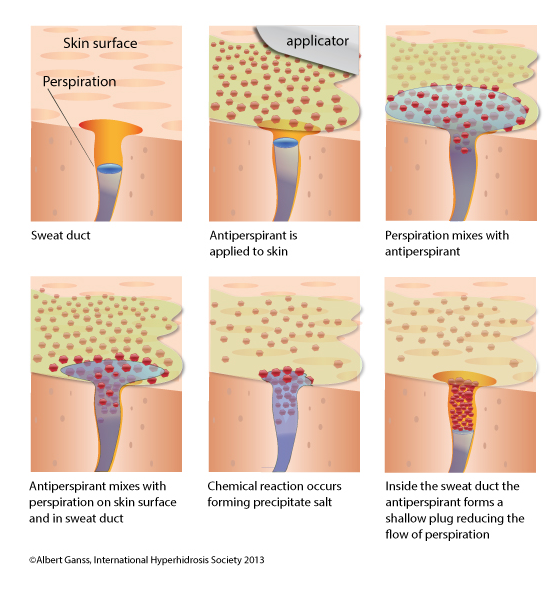

Antiperspirants are considered the first line of treatment for excessive sweating of the underarms, hands, feet, and sometimes face. They are called the first line of treatment because they are the least invasive and experts recommend that they be tried first, before other more invasive treatments. They are also inexpensive and easy to use even when following our tips!
Antiperspirants are applied to the top of the skin (which is why you sometimes hear them called "topical" treatments). Once an antiperspirant is applied to the skin, perspiration in the underarm grabs and dissolves the antiperspirant particles, pulling them into the pores and forming superficial plugs that are just below the surface of the skin. When your body senses that the sweat duct is plugged, a feedback mechanism stops the flow. The plugs can stay in place for at least 24 hours and then are washed away over time.

Antiperspirants are available either over-the-counter (OTC) or by prescription from your healthcare provider.
Over-the-counter antiperspirants are now available in different strengths with “clinical” strength products offering the most sweat protection (but at a higher cost). Clinical strength products seem to provide improved sweat reduction compared to traditional over-the-counter antiperspirants, and with less skin irritation than prescription products.
The most widely used active ingredients in antiperspirants are metallic salts. Clinical strength antiperspirants contain higher concentrations of active ingredients than “regular” strength over-the-counter antiperspirants. Clinical strength antiperspirants usually contain up to 20% active ingredients compared to 10% in regular formulas.
Examples of common active ingredients in OTC antiperspirants:
Prescription and specialty antiperspirants often contain aluminum chloride hexahydrate as an active ingredient. These are among the most effective antiperspirants, but can cause skin irritation if instructions aren’t followed precisely. Typically, aluminum chloride hexahydrate concentrations of 10% to 15% are recommended for excessive sweating of the underarms. For managing sweaty hands or sweaty feet, higher concentrations are needed - usually around 30%.
In general, experts recommend a systematic approach to combating hyperhidrosis with antiperspirants. Start with the most gentle-to-the-skin formulations (traditional over-the-counter products) and progress to clinical strength over-the-counter antiperspirants, and then try stronger and stronger products (such as prescription formulations) until relief is found.
Avoiding skin irritation is the key to success with antiperspirants, prescription and non-prescription alike: follow the product’s instructions, follow your dermatologist’s recommendations, apply at night before bed as opposed to only in the morning, and apply to completely dry skin.
It’s common to think that antiperspirants are just for sweaty underarms, but it’s time to think outside the pit! Learn where else you can glide, stick, spray, and roll on by clicking here.
Next Steps
Have you talked to your provider about excessive sweating? If not, now is the time! Learn more about how you and your healthcare team can work together to find the right treatment, or combination of treatments, to manage your hyperhidrosis.
If antiperspirants alone aren’t effective enough, talk to a practitioner about other excessive sweating treatment options. Our Clinician Finder can help you locate practitioners who treat hyperhidrosis. We also have information and resources to help you prepare for your appointment.
Have an informed discussion with your healthcare team by learning about all of the available treatment options for each of these body areas that may be affected by excessive sweating:
And remember, because hyperhidrosis is a serious medical condition - you deserve insurance coverage and reimbursement for your medical visits and treatment. We've got tips to help you navigate the health insurance realm; visit Insurance Tools for more information.
For the latest news about treatments, special events, and other developments, sign-up for our free blog. And please help to support our work by:
Latest Blogs